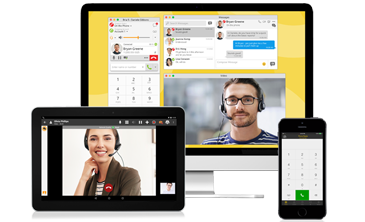Telecommuting is not a recent phenomenon. There has been a lot of research and experimentation with it as technology has developed to make it easier to work from a distance. Recently, the COVID-19 health crisis has forced businesses and their employees with no feasible alternative but to work from home. Most workers were not prepared for the change and will find many aspects of working from home hard to deal with. Even those who were set up with a workplace at home will find that the limitations imposed by self-isolation raise new problems. Telecommuters must find a healthy work-life balance by curating their physical surroundings, keeping track of how they spend their time, prioritizing the health of their bodies, and making the right adjustments to their communication.
Working from Home Tip 1: Set up Proper Ergonomics
You need an area that allows you to focus on your work, like putting on a glove that’s been stretched to perfectly fit your hand. As appealing as working from the couch may seem, it may not be the best choice in the long run. Set up a space that is reserved for work so that your mind is focused when you enter that space and then disconnect when you remove yourself from that area. There are many tried-and-true tips for ergonomic well-being that have been implemented in office spaces.

For one, give yourself space to spread out with everything you need just like you would have in an office or cubicle at work. Position your desk so there’s no glare on your computer screen, and adjust the brightness to avoid eye-strain. Go for a chair which provides lumbar support and adjust your chair height so that your feet rest comfortably on the floor. Another thing that might help is to find music that sets the right tone for you to feel productive. You want your space to be comfortable but not sleep-inducing. If you can, convert an entire room into an office space, but if not, try and maintain your office setup permanently. The goal is to create a physical barrier between work and home life, even if it’s an artificial boundary. This way your mind will have an easier time entering into work mode in the morning, taking breaks during the day and disconnecting from work at the end of the day.
Working from Home Tip 2: Find Time Management Techniques that Work for You
Telecommuters have different challenges depending on their industry or position in the company. Some research has found productivity increased while working from home, but other studies have shown this can take a toll on mental health. For employees who already work within a structured environment studies have shown that productivity increases. For instance, for call center employees the nature of their work requires very little self-organization, thus making it easier to maintain a healthy work-life balance. However, there have been other cases where a lack of work and managerial tools for oversight led to time fraud.

If you don’t have a supervisor providing you with specific goals for the day, then you must set some for yourself. Make sure they are achievable goals, that allow for some flexibility. Spend an hour dedicated to answering emails. Be selective in which work chat messaging channels you keep open, so that you can focus on your goals for the day without getting distracted. Set up a team meeting early in the day to get ideas percolating. Set up a list of priorities and give yourself a deadline for the day. Many employees find themselves working longer hours at home in an effort to prove to their supervisors that they are actually working. Allow yourself to be flexible with your actual working hours because you have that freedom, but also stop when it’s time to stop because burnout is a real possibility.
Working from Home Tip 3: Remember to Move Around
The benefits of physical movement are easy to take for granted going into a traditional office, and this isn’t only about going to the gym. Research has shown how essential it is to move your body to break up periods of sitting. Typically employees walk, bike or take public transportation to and from work. If you drive, it even counts just to walk from your parking spot into the office. Then add up all the movement you take for granted: moving around to different offices for meetings, grabbing a coffee, going for lunch or meeting clients. All of these small movements are eliminated from your day when you work from home and it can be detrimental to your health. Working from home requires you to be much more conscious of how much you are moving because it doesn’t happen organically any more.

On the other hand it’s possible to take advantage of being at home by finding novel ways to break up periods of sitting. Maybe that means walking your dog, having tea on your balcony, tending to your plants. Make time for something fun, something that’s just for you.
Employees in an office setting will adjust their behaviour according to social codes. You might get looks if you stand up, play a heavy metal song and start head-banging. At home you can feel free to do this (or something similar). If you have children, spend a few moments playing with them. Do the same if you own a pet. Chances are, any of these may be clamouring for your attention anyhow. Take your lunch away from your workspace, and make it a family or social moment if you can. Completely excluding your home life while you work may be too drastic, especially for your physical health. Don’t feel bad about letting your surroundings distract you for short periods, as it may be more beneficial to your work than trying to shut them out.
Working from Home Tip 4: Effective Team Communication
The biggest challenge for telecommuters is the feeling of isolation. Lack of communication can lead to frustration and added anxiety. Without the visual back and forth when you’re communicating with colleagues it’s easy to imagine you have to handle everything on your own. This can sometimes lead to learning a new skill, but can also lead to feeling out of the loop and overburdened. If you’re unsure of something, or need extra guidance, reach out to your colleagues. Supervisors play a critical role in making their employees feel like part of the team.
A video conferencing solution, like Bria Solo, Bria Teams and Bria Enterprise, allows teams to take their business number with them, regardless of where they are and which device they are using. It also provides additional tools to easily share a presentation on screen, and meet face-to-face on video calls.
Managers may worry that employees will not be as focused or committed when working from home, but research has found this not to be the case. The idea that everyone else is being productive is enough of a motivation for a worker to pitch in. Daily meetings are key, as employees must first feel like they’re part of a team. A meeting in the office setting rarely offers a chance for chitchat at the table, but the communal office space allows for plenty of water-cooler talk outside that meeting.

The host of the video conference should encourage some banter and allow team members to share tidbits from their personal lives to the group. They should also share general updates within the company to provide team members context for the work they do. Employees should then schedule a time to check in with their closest coworkers later in the day to discuss the progress they’re making.
CounterPath Bria Solo and Bria Teams solutions are available with a 30-day free trial from our website, or contact one of Channel Partners or sales representatives for a demo of our Bria Enterprise solution today.






